How Companies Use SWOT Analysis as a Strategic Tool for Success
VerifiedAdded on 2023/04/03
|8
|1479
|336
Essay
AI Summary
This essay provides a detailed analysis of SWOT (Strengths, Weaknesses, Opportunities, and Threats) as a strategic tool for business success. It defines SWOT analysis, explaining its components and highlighting its flexibility across various industries and departments. The paper outlines when and how to conduct a SWOT analysis, including data collection, identification of threats and opportunities, and review of the SWOT matrix for strategic planning. A checklist of potential SWOT factors and a real-life example of Microsoft's SWOT analysis are provided to illustrate the practical application of the tool. The essay concludes that SWOT analysis is crucial for strategic planning, emphasizing the importance of pre-preparation and relevant data collection for effective implementation.

Running head: USING SWOT ANALYSIS AS A STRATEGIC TOOL
Using SWOT Analysis as a Strategic Tool
Name of the Student:
Name of the University:
Author note:
Using SWOT Analysis as a Strategic Tool
Name of the Student:
Name of the University:
Author note:
Paraphrase This Document
Need a fresh take? Get an instant paraphrase of this document with our AI Paraphraser
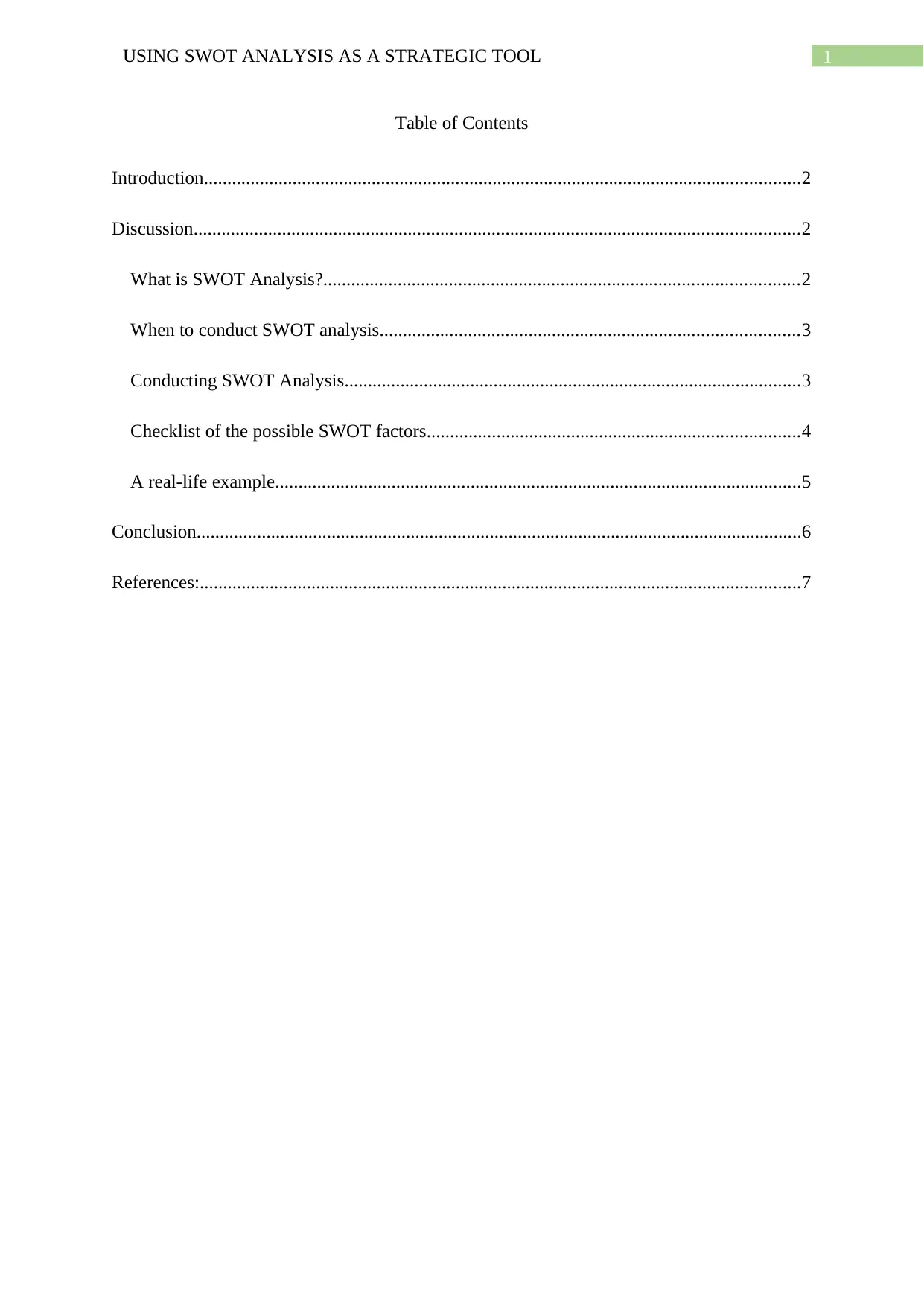
1USING SWOT ANALYSIS AS A STRATEGIC TOOL
Table of Contents
Introduction................................................................................................................................2
Discussion..................................................................................................................................2
What is SWOT Analysis?......................................................................................................2
When to conduct SWOT analysis..........................................................................................3
Conducting SWOT Analysis..................................................................................................3
Checklist of the possible SWOT factors................................................................................4
A real-life example.................................................................................................................5
Conclusion..................................................................................................................................6
References:.................................................................................................................................7
Table of Contents
Introduction................................................................................................................................2
Discussion..................................................................................................................................2
What is SWOT Analysis?......................................................................................................2
When to conduct SWOT analysis..........................................................................................3
Conducting SWOT Analysis..................................................................................................3
Checklist of the possible SWOT factors................................................................................4
A real-life example.................................................................................................................5
Conclusion..................................................................................................................................6
References:.................................................................................................................................7

2USING SWOT ANALYSIS AS A STRATEGIC TOOL
1. Introduction
SWOT stands of Strengths, Weaknesses, Opportunities and Threats. It is to note that
SWOT analysis refers to a strategic planning for identification and understanding of the
strengths, weaknesses, opportunities and threats that affect a particular business, situation or a
project. According to Bull et al. (2015), it is a highly flexible tool and can help in decision
making process in every circumstances. This paper shall elaborate on discussing how
companies can make use of SWOT analysis as a strategic tool for overall business success.
2. Discussion
2.1. What is SWOT Analysis?
As already mentioned, SWOT represents Strengths, Weaknesses, Opportunities and
Threats. It is a tool that is basically used for the evaluation of the internal (strengths and
weaknesses) and external (opportunities and threats) of a company. It is often called TWOS
analysis (Gurel & Tat, 2017). It is to note that a SWOT analysis starts by collection of data
and information about an organisation or a project and ends with a solid decision on the basis
of interpretation of the details and information that are summarised in the matrix. According
to Bohari, Hin and Fuad (2017), it is a very useful way of drawing together the analysis of the
external and internal environment of an organisation. It is a planning methodology that helps
an organisation to build a strategic plan in order to meet the business goals and improve the
business operations while keeping the business relevant
Strengths- Strengths refer to the positive attributes that the internal to the organisation
or the situation that are under or within the control.
1. Introduction
SWOT stands of Strengths, Weaknesses, Opportunities and Threats. It is to note that
SWOT analysis refers to a strategic planning for identification and understanding of the
strengths, weaknesses, opportunities and threats that affect a particular business, situation or a
project. According to Bull et al. (2015), it is a highly flexible tool and can help in decision
making process in every circumstances. This paper shall elaborate on discussing how
companies can make use of SWOT analysis as a strategic tool for overall business success.
2. Discussion
2.1. What is SWOT Analysis?
As already mentioned, SWOT represents Strengths, Weaknesses, Opportunities and
Threats. It is a tool that is basically used for the evaluation of the internal (strengths and
weaknesses) and external (opportunities and threats) of a company. It is often called TWOS
analysis (Gurel & Tat, 2017). It is to note that a SWOT analysis starts by collection of data
and information about an organisation or a project and ends with a solid decision on the basis
of interpretation of the details and information that are summarised in the matrix. According
to Bohari, Hin and Fuad (2017), it is a very useful way of drawing together the analysis of the
external and internal environment of an organisation. It is a planning methodology that helps
an organisation to build a strategic plan in order to meet the business goals and improve the
business operations while keeping the business relevant
Strengths- Strengths refer to the positive attributes that the internal to the organisation
or the situation that are under or within the control.
⊘ This is a preview!⊘
Do you want full access?
Subscribe today to unlock all pages.

Trusted by 1+ million students worldwide
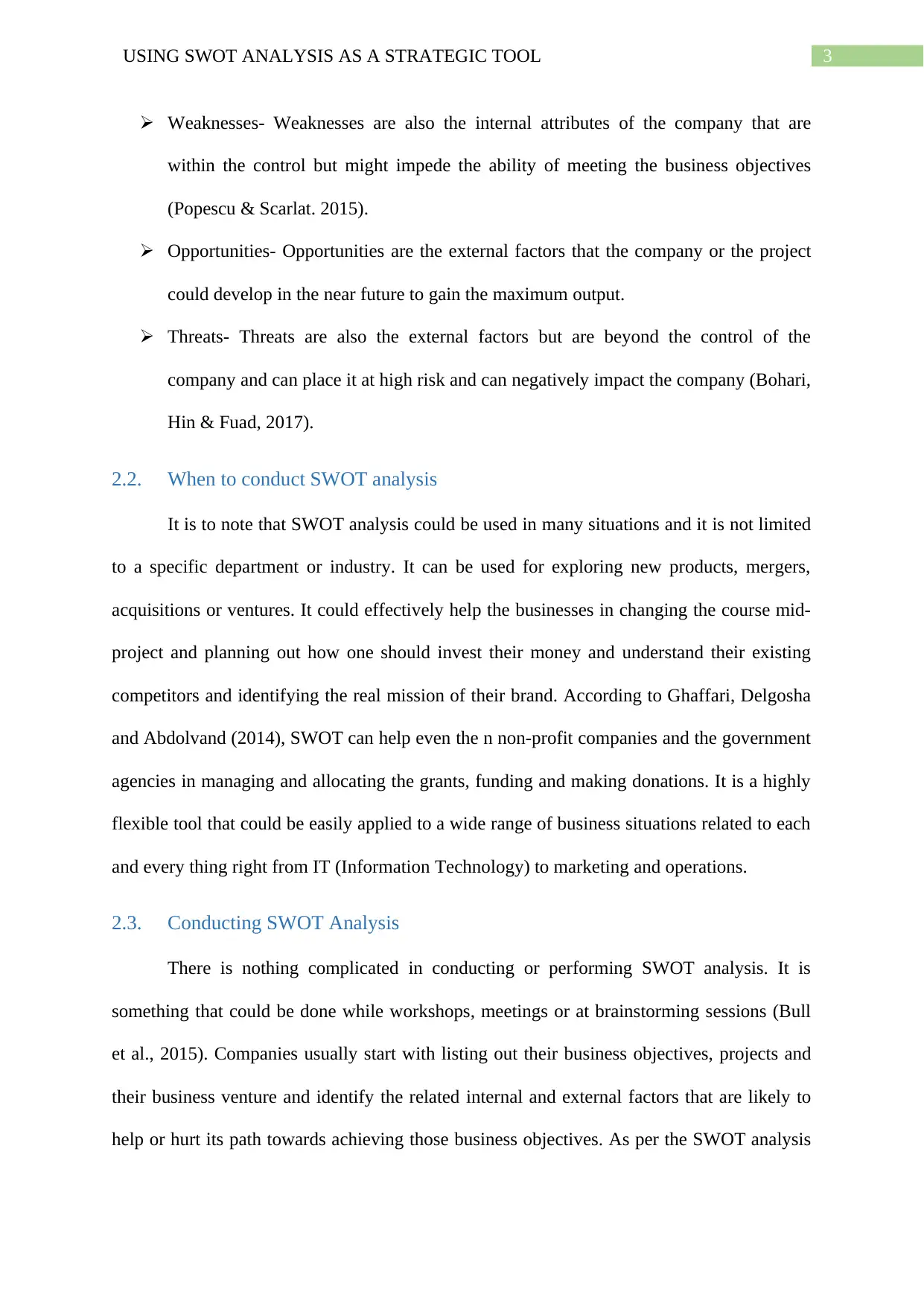
3USING SWOT ANALYSIS AS A STRATEGIC TOOL
Weaknesses- Weaknesses are also the internal attributes of the company that are
within the control but might impede the ability of meeting the business objectives
(Popescu & Scarlat. 2015).
Opportunities- Opportunities are the external factors that the company or the project
could develop in the near future to gain the maximum output.
Threats- Threats are also the external factors but are beyond the control of the
company and can place it at high risk and can negatively impact the company (Bohari,
Hin & Fuad, 2017).
2.2. When to conduct SWOT analysis
It is to note that SWOT analysis could be used in many situations and it is not limited
to a specific department or industry. It can be used for exploring new products, mergers,
acquisitions or ventures. It could effectively help the businesses in changing the course mid-
project and planning out how one should invest their money and understand their existing
competitors and identifying the real mission of their brand. According to Ghaffari, Delgosha
and Abdolvand (2014), SWOT can help even the n non-profit companies and the government
agencies in managing and allocating the grants, funding and making donations. It is a highly
flexible tool that could be easily applied to a wide range of business situations related to each
and every thing right from IT (Information Technology) to marketing and operations.
2.3. Conducting SWOT Analysis
There is nothing complicated in conducting or performing SWOT analysis. It is
something that could be done while workshops, meetings or at brainstorming sessions (Bull
et al., 2015). Companies usually start with listing out their business objectives, projects and
their business venture and identify the related internal and external factors that are likely to
help or hurt its path towards achieving those business objectives. As per the SWOT analysis
Weaknesses- Weaknesses are also the internal attributes of the company that are
within the control but might impede the ability of meeting the business objectives
(Popescu & Scarlat. 2015).
Opportunities- Opportunities are the external factors that the company or the project
could develop in the near future to gain the maximum output.
Threats- Threats are also the external factors but are beyond the control of the
company and can place it at high risk and can negatively impact the company (Bohari,
Hin & Fuad, 2017).
2.2. When to conduct SWOT analysis
It is to note that SWOT analysis could be used in many situations and it is not limited
to a specific department or industry. It can be used for exploring new products, mergers,
acquisitions or ventures. It could effectively help the businesses in changing the course mid-
project and planning out how one should invest their money and understand their existing
competitors and identifying the real mission of their brand. According to Ghaffari, Delgosha
and Abdolvand (2014), SWOT can help even the n non-profit companies and the government
agencies in managing and allocating the grants, funding and making donations. It is a highly
flexible tool that could be easily applied to a wide range of business situations related to each
and every thing right from IT (Information Technology) to marketing and operations.
2.3. Conducting SWOT Analysis
There is nothing complicated in conducting or performing SWOT analysis. It is
something that could be done while workshops, meetings or at brainstorming sessions (Bull
et al., 2015). Companies usually start with listing out their business objectives, projects and
their business venture and identify the related internal and external factors that are likely to
help or hurt its path towards achieving those business objectives. As per the SWOT analysis
Paraphrase This Document
Need a fresh take? Get an instant paraphrase of this document with our AI Paraphraser
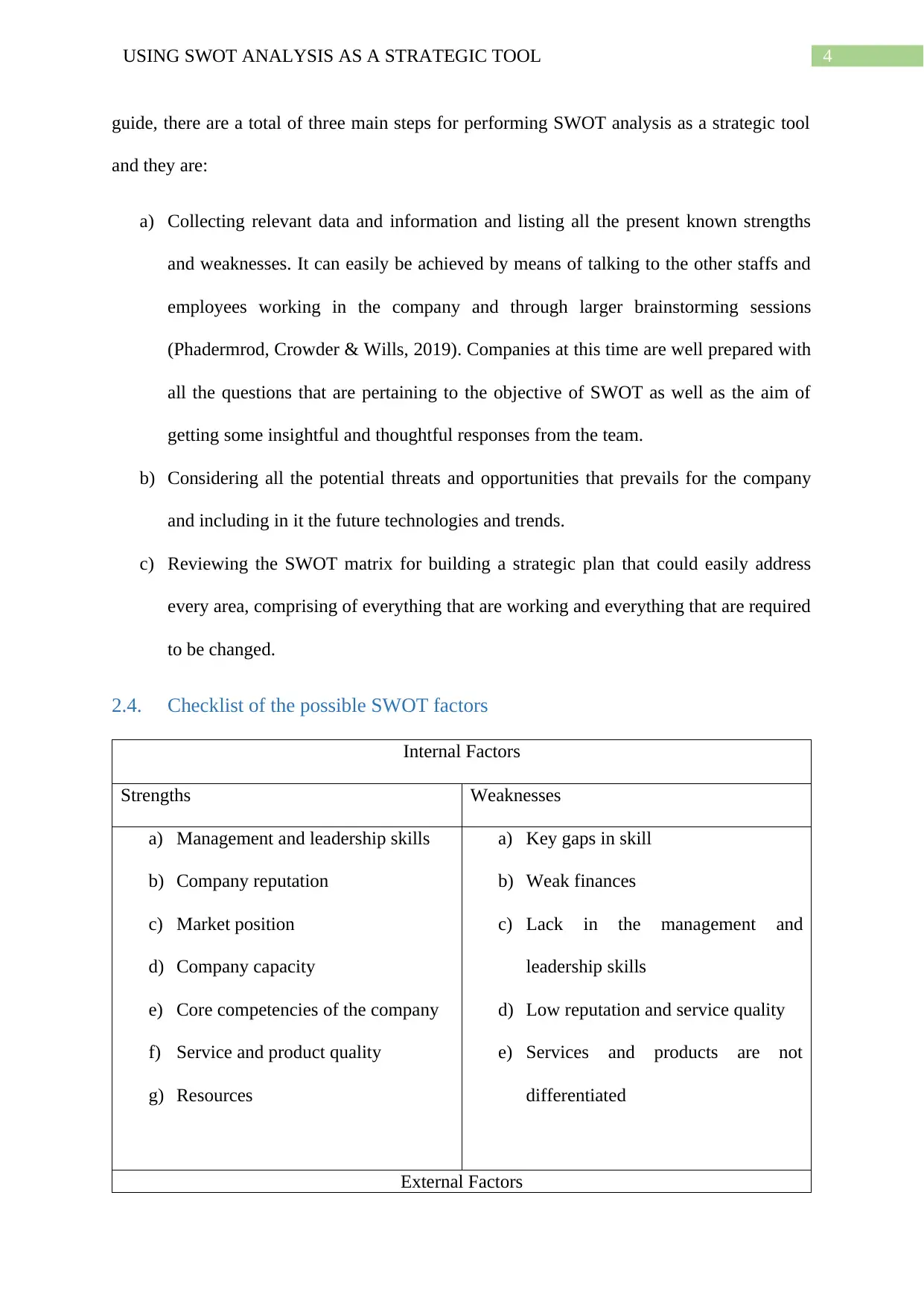
4USING SWOT ANALYSIS AS A STRATEGIC TOOL
guide, there are a total of three main steps for performing SWOT analysis as a strategic tool
and they are:
a) Collecting relevant data and information and listing all the present known strengths
and weaknesses. It can easily be achieved by means of talking to the other staffs and
employees working in the company and through larger brainstorming sessions
(Phadermrod, Crowder & Wills, 2019). Companies at this time are well prepared with
all the questions that are pertaining to the objective of SWOT as well as the aim of
getting some insightful and thoughtful responses from the team.
b) Considering all the potential threats and opportunities that prevails for the company
and including in it the future technologies and trends.
c) Reviewing the SWOT matrix for building a strategic plan that could easily address
every area, comprising of everything that are working and everything that are required
to be changed.
2.4. Checklist of the possible SWOT factors
Internal Factors
Strengths Weaknesses
a) Management and leadership skills
b) Company reputation
c) Market position
d) Company capacity
e) Core competencies of the company
f) Service and product quality
g) Resources
a) Key gaps in skill
b) Weak finances
c) Lack in the management and
leadership skills
d) Low reputation and service quality
e) Services and products are not
differentiated
External Factors
guide, there are a total of three main steps for performing SWOT analysis as a strategic tool
and they are:
a) Collecting relevant data and information and listing all the present known strengths
and weaknesses. It can easily be achieved by means of talking to the other staffs and
employees working in the company and through larger brainstorming sessions
(Phadermrod, Crowder & Wills, 2019). Companies at this time are well prepared with
all the questions that are pertaining to the objective of SWOT as well as the aim of
getting some insightful and thoughtful responses from the team.
b) Considering all the potential threats and opportunities that prevails for the company
and including in it the future technologies and trends.
c) Reviewing the SWOT matrix for building a strategic plan that could easily address
every area, comprising of everything that are working and everything that are required
to be changed.
2.4. Checklist of the possible SWOT factors
Internal Factors
Strengths Weaknesses
a) Management and leadership skills
b) Company reputation
c) Market position
d) Company capacity
e) Core competencies of the company
f) Service and product quality
g) Resources
a) Key gaps in skill
b) Weak finances
c) Lack in the management and
leadership skills
d) Low reputation and service quality
e) Services and products are not
differentiated
External Factors

5USING SWOT ANALYSIS AS A STRATEGIC TOOL
Opportunities Threats
a) The present economic growth
b) Market growth
c) Global influences
d) Demographic change
e) New services and products preferred
by the customers
f) Weak competitors
g) Change in the economic and
political environment
h) New technological developments
a) Technological threat
b) New entrants in the market within
same industry
c) Slow growth
d) Increased level of competition
e) Global warming
f) Change in the economic and
political environment
g) Economic downturn
2.5. A real-life example
It is to mention that SWOT analysis from the major companies could help in getting a
good idea of how the entire process actually works. If we consider an example of SWOT
analysis of Microsoft we would find that it evaluates the potential impact of the main
leadership change in this organisation.
Strengths- It can be identified that the significant strengths of Microsoft are its brand
awareness, its easy to use products and services, its world-wide acceptance as an
enterprise, the wide network of distributors of the company as well as the potential of
the company to beat the expectations of the analyst.
Weaknesses- On the other hand, the major weaknesses of the company include the
fact that it has emerged lately to mobile computing, the shortage of urgency while the
Opportunities Threats
a) The present economic growth
b) Market growth
c) Global influences
d) Demographic change
e) New services and products preferred
by the customers
f) Weak competitors
g) Change in the economic and
political environment
h) New technological developments
a) Technological threat
b) New entrants in the market within
same industry
c) Slow growth
d) Increased level of competition
e) Global warming
f) Change in the economic and
political environment
g) Economic downturn
2.5. A real-life example
It is to mention that SWOT analysis from the major companies could help in getting a
good idea of how the entire process actually works. If we consider an example of SWOT
analysis of Microsoft we would find that it evaluates the potential impact of the main
leadership change in this organisation.
Strengths- It can be identified that the significant strengths of Microsoft are its brand
awareness, its easy to use products and services, its world-wide acceptance as an
enterprise, the wide network of distributors of the company as well as the potential of
the company to beat the expectations of the analyst.
Weaknesses- On the other hand, the major weaknesses of the company include the
fact that it has emerged lately to mobile computing, the shortage of urgency while the
⊘ This is a preview!⊘
Do you want full access?
Subscribe today to unlock all pages.

Trusted by 1+ million students worldwide
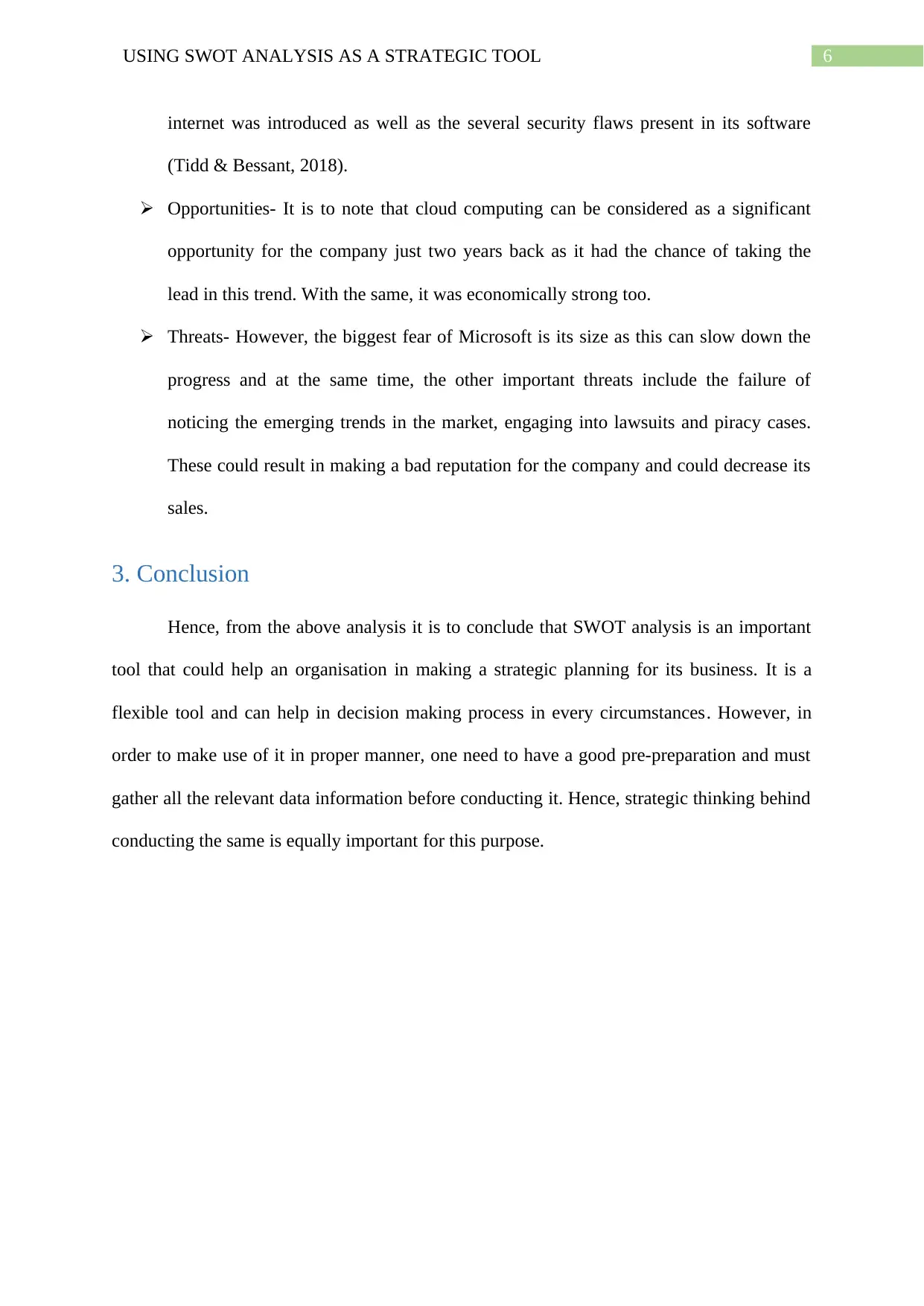
6USING SWOT ANALYSIS AS A STRATEGIC TOOL
internet was introduced as well as the several security flaws present in its software
(Tidd & Bessant, 2018).
Opportunities- It is to note that cloud computing can be considered as a significant
opportunity for the company just two years back as it had the chance of taking the
lead in this trend. With the same, it was economically strong too.
Threats- However, the biggest fear of Microsoft is its size as this can slow down the
progress and at the same time, the other important threats include the failure of
noticing the emerging trends in the market, engaging into lawsuits and piracy cases.
These could result in making a bad reputation for the company and could decrease its
sales.
3. Conclusion
Hence, from the above analysis it is to conclude that SWOT analysis is an important
tool that could help an organisation in making a strategic planning for its business. It is a
flexible tool and can help in decision making process in every circumstances. However, in
order to make use of it in proper manner, one need to have a good pre-preparation and must
gather all the relevant data information before conducting it. Hence, strategic thinking behind
conducting the same is equally important for this purpose.
internet was introduced as well as the several security flaws present in its software
(Tidd & Bessant, 2018).
Opportunities- It is to note that cloud computing can be considered as a significant
opportunity for the company just two years back as it had the chance of taking the
lead in this trend. With the same, it was economically strong too.
Threats- However, the biggest fear of Microsoft is its size as this can slow down the
progress and at the same time, the other important threats include the failure of
noticing the emerging trends in the market, engaging into lawsuits and piracy cases.
These could result in making a bad reputation for the company and could decrease its
sales.
3. Conclusion
Hence, from the above analysis it is to conclude that SWOT analysis is an important
tool that could help an organisation in making a strategic planning for its business. It is a
flexible tool and can help in decision making process in every circumstances. However, in
order to make use of it in proper manner, one need to have a good pre-preparation and must
gather all the relevant data information before conducting it. Hence, strategic thinking behind
conducting the same is equally important for this purpose.
Paraphrase This Document
Need a fresh take? Get an instant paraphrase of this document with our AI Paraphraser
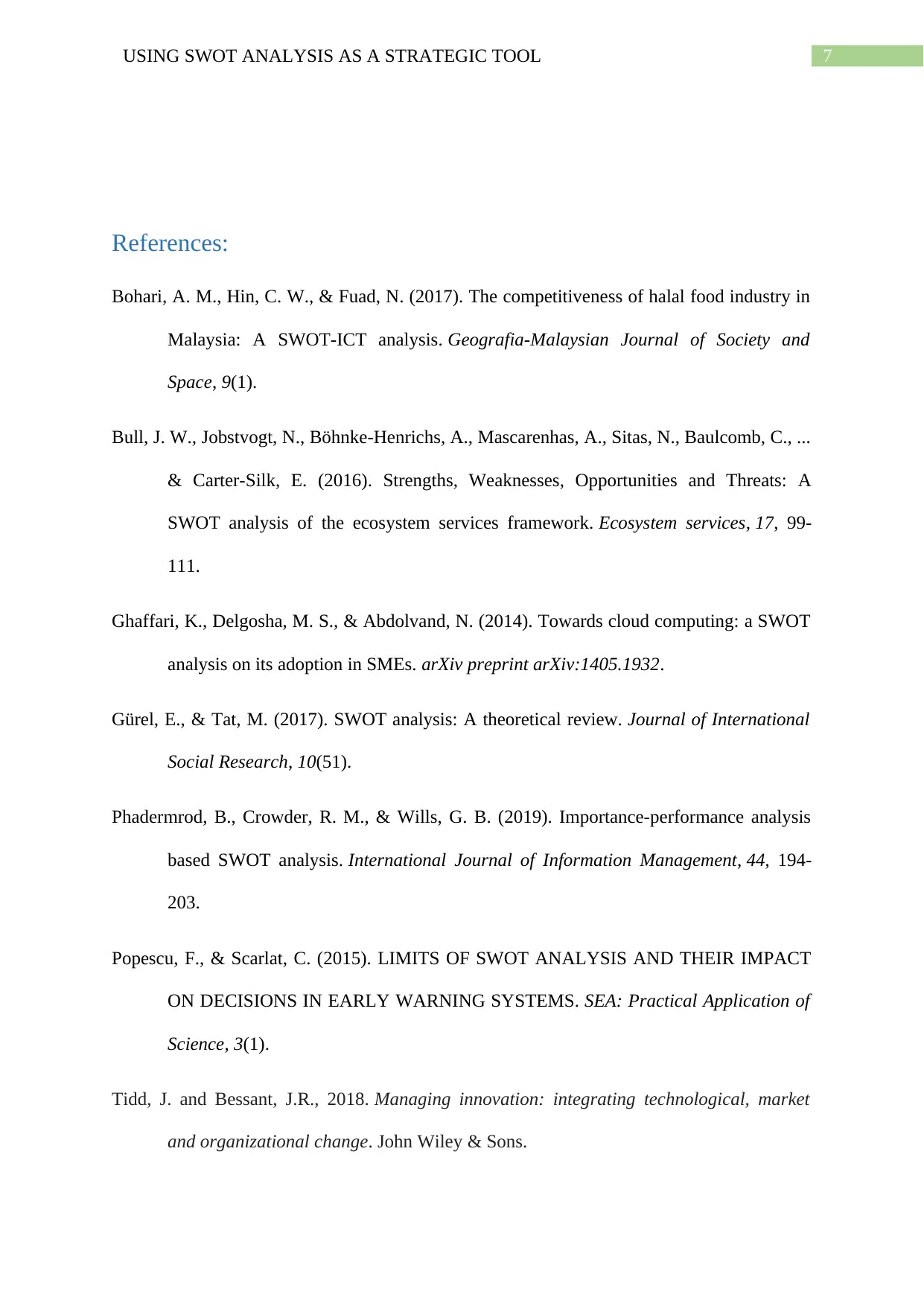
7USING SWOT ANALYSIS AS A STRATEGIC TOOL
References:
Bohari, A. M., Hin, C. W., & Fuad, N. (2017). The competitiveness of halal food industry in
Malaysia: A SWOT-ICT analysis. Geografia-Malaysian Journal of Society and
Space, 9(1).
Bull, J. W., Jobstvogt, N., Böhnke-Henrichs, A., Mascarenhas, A., Sitas, N., Baulcomb, C., ...
& Carter-Silk, E. (2016). Strengths, Weaknesses, Opportunities and Threats: A
SWOT analysis of the ecosystem services framework. Ecosystem services, 17, 99-
111.
Ghaffari, K., Delgosha, M. S., & Abdolvand, N. (2014). Towards cloud computing: a SWOT
analysis on its adoption in SMEs. arXiv preprint arXiv:1405.1932.
Gürel, E., & Tat, M. (2017). SWOT analysis: A theoretical review. Journal of International
Social Research, 10(51).
Phadermrod, B., Crowder, R. M., & Wills, G. B. (2019). Importance-performance analysis
based SWOT analysis. International Journal of Information Management, 44, 194-
203.
Popescu, F., & Scarlat, C. (2015). LIMITS OF SWOT ANALYSIS AND THEIR IMPACT
ON DECISIONS IN EARLY WARNING SYSTEMS. SEA: Practical Application of
Science, 3(1).
Tidd, J. and Bessant, J.R., 2018. Managing innovation: integrating technological, market
and organizational change. John Wiley & Sons.
References:
Bohari, A. M., Hin, C. W., & Fuad, N. (2017). The competitiveness of halal food industry in
Malaysia: A SWOT-ICT analysis. Geografia-Malaysian Journal of Society and
Space, 9(1).
Bull, J. W., Jobstvogt, N., Böhnke-Henrichs, A., Mascarenhas, A., Sitas, N., Baulcomb, C., ...
& Carter-Silk, E. (2016). Strengths, Weaknesses, Opportunities and Threats: A
SWOT analysis of the ecosystem services framework. Ecosystem services, 17, 99-
111.
Ghaffari, K., Delgosha, M. S., & Abdolvand, N. (2014). Towards cloud computing: a SWOT
analysis on its adoption in SMEs. arXiv preprint arXiv:1405.1932.
Gürel, E., & Tat, M. (2017). SWOT analysis: A theoretical review. Journal of International
Social Research, 10(51).
Phadermrod, B., Crowder, R. M., & Wills, G. B. (2019). Importance-performance analysis
based SWOT analysis. International Journal of Information Management, 44, 194-
203.
Popescu, F., & Scarlat, C. (2015). LIMITS OF SWOT ANALYSIS AND THEIR IMPACT
ON DECISIONS IN EARLY WARNING SYSTEMS. SEA: Practical Application of
Science, 3(1).
Tidd, J. and Bessant, J.R., 2018. Managing innovation: integrating technological, market
and organizational change. John Wiley & Sons.
1 out of 8
Related Documents
Your All-in-One AI-Powered Toolkit for Academic Success.
+13062052269
info@desklib.com
Available 24*7 on WhatsApp / Email
![[object Object]](/_next/static/media/star-bottom.7253800d.svg)
Unlock your academic potential
Copyright © 2020–2025 A2Z Services. All Rights Reserved. Developed and managed by ZUCOL.





